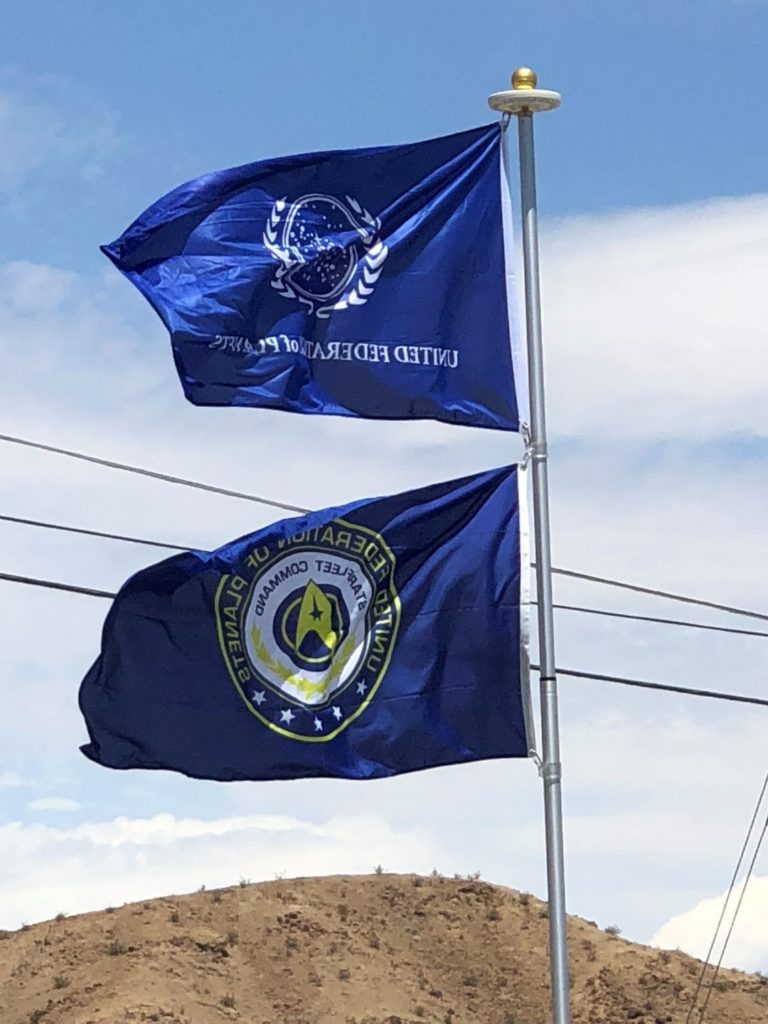Not all the flags that we fly are representative of political entities nor are they all reflective of social movements or serious political realities. Every once in a while we just have fun with a popular culture reference such as today’s flags that reflect fictional institutions from the Star Trek franchise.

The top flag represents the United Federation of Planets. To quote the website Memory Alpha’s introduction to the United Federation of Planets:
“The United Federation of Planets (abbreviated as UFP and commonly referred to as the Federation) was an interstellar federal republic, composed of planetary governments that agreed to exist semi-autonomously under a single central government based on the principles of universal liberty, rights, and equality, and to share their knowledge and resources in peaceful cooperation, scientific development, space exploration and defensive purposes.”
Anyone who has watched even one episode or one movie in the Star Trek franchise has surely heard of the Federation in one context or another, often in the form of various Federation codes, rules, directives, and regulations, which is what one would expect from a large interstellar administrative organization. Star Trek is essentially built as an alternate universe around the central pillar of the Federation.

The second flag represents Star Fleet Command: Again, to quote the website Memory Alpha’s introduction to Starfleet Command:
“Starfleet Command, or Spacefleet Command, was the operating authority of Starfleet, the exploratory, scientific, and military department of United Earth before being integrated into the United Federation of Planets in 2161. The organization’s primary management center was located at Starfleet Headquarters in San Francisco, Earth.”
Starfleet also figures large in many of the episodes and movies in the Star Trek franchise. It is clearly subordinate to the overall Federation and, to my eyes at least, has a distinctly militaristic tone in the way it is portrayed and discussed, similar in my mind to the naval command of a sovereign nation. Clearly Starfleet officers perform non-militaristic roles such as scientists and medical staff, but they are all clearly trained in basic military protocols, self-defense, and weapons use. Again, this reminds me very distinctly of the structure and function of the modern military and I have to assume that this resemblance was not an accident when the series first debuted. And, granted, the original series is much more focused on physical conflict than are the later series, perhaps reflective of the television sensibilities of the time and also to provide an opportunity for Captain Kirk, in the form of William Shatner, to show off what passed at the time as an impressive physique.

I don’t necessarily consider myself to be a “Trekkie” but I have watched all of the movies and the broadcast series. I remain most intensely fond of Star Trek: Next Generation and Star Trek: Voyager. I have long enjoyed the way that each episode, adhering to Gene Roddenberry’s original vision, uses the trope of a future civilization to comment on and analyze current social and political issues, often long before they reach the point of common consideration in modern culture. Star Trek has tackled everything from gay rights to racism with many other stops along the way. Sometimes, especially when portraying the first inter-racial kiss on television, the controversial action or dialogue was acceptable because it happened in a future timeline or in another civilization such that it wasn’t considered as radical or threatening as it might otherwise have been.
